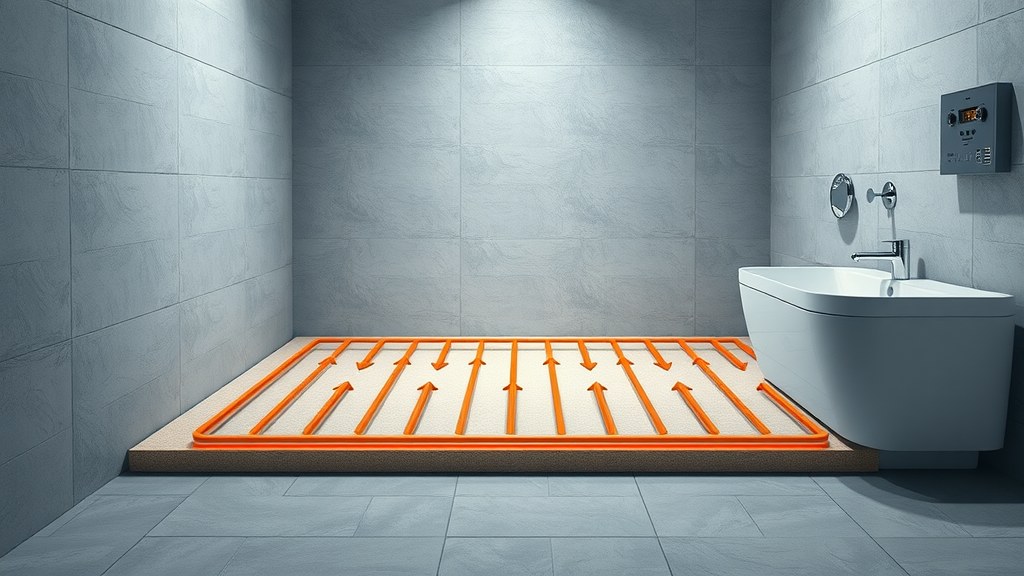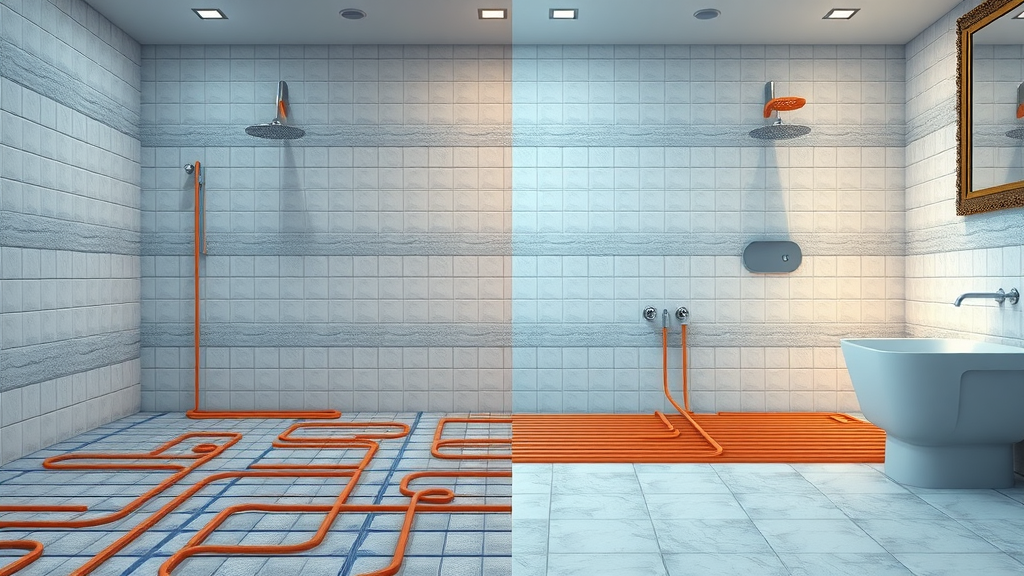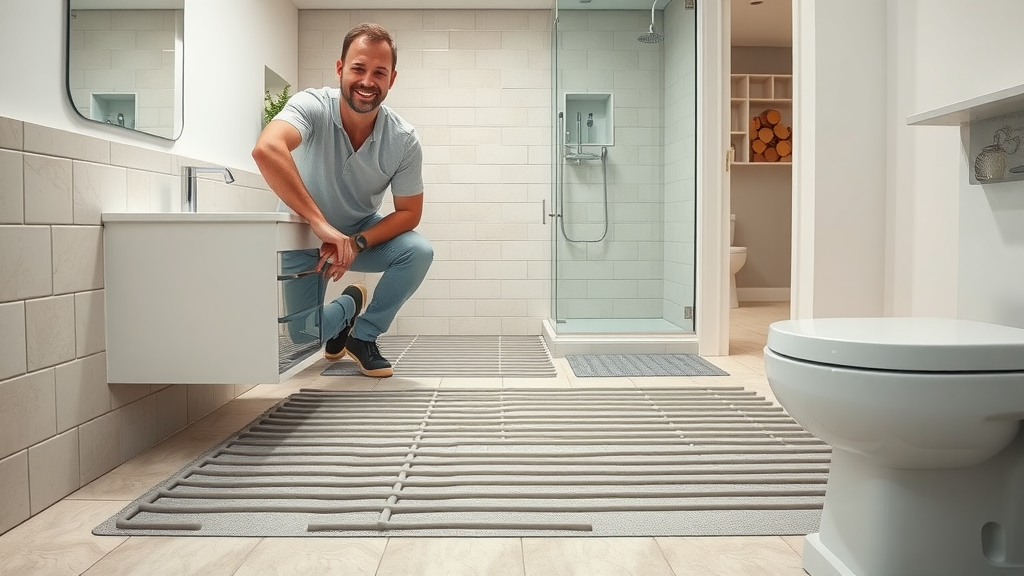
Did you know? According to Peak Underfloor Heating Ltd, modern underfloor heating systems can be up to 25% more efficient than traditional radiators. With energy prices and home comfort becoming prime concerns for UK homeowners, installing underfloor heating for a bathroom renovation is fast becoming a top priority. In this complete guide, you’ll discover everything—from the basics, types, installation, costs, to expert tips for maximising comfort and efficiency. If you want your bathroom to feel truly luxurious and future-proof, this is your ultimate starting point.
Startling Facts: Why Underfloor Heating for a Bathroom Renovation is Transforming UK Homes
"Did you know that modern underfloor heating systems can be up to 25% more efficient than traditional radiators?" – Peak Underfloor Heating Ltd
Underfloor heating is changing the way homeowners think about comfort and energy use during a bathroom renovation. More than ever, families and property advisors are re-evaluating old radiator setups. Why? Because floor heating increases comfort, makes energy bills more predictable, and fits perfectly into modern bathroom designs. Bathrooms, often among the coldest spaces in the home, benefit tremendously from the reliable and consistent warmth only an underfloor heating system can provide. Imagine stepping onto a warm tiled floor on a chilly morning—no more shivering or dashing for slippers!
In addition, installing a bathroom underfloor heating system has become easier and less invasive, thanks to improved insulation board technology and smarter heating controls. This means both new builds and older homes undergoing a renovation project can enjoy these benefits. Not just a luxury, underfloor heating for bathrooms now offers a real return on investment by both reducing running costs and boosting property value.
What You’ll Learn About Underfloor Heating for a Bathroom Renovation
- The basics of underfloor heating for bathroom renovations
- Types of floor heating systems (electric underfloor heating and wet underfloor heating)
- Key steps and considerations for installation during a bathroom renovation
- Costs, benefits, and common misconceptions
- Why Peak Underfloor Heating Ltd is your trusted installation partner
Understanding Underfloor Heating for Bathroom Renovations: The Basics
What is Underfloor Heating and How Does It Work in Bathroom Renovations?

Underfloor heating, also known as floor heating, is a hidden system that delivers warmth evenly across your bathroom floor—unlike traditional radiators, which heat air from one side of the room. Electric underfloor heating uses a heating mat or flexible heating cable installed directly beneath your tiles, while wet underfloor heating (or "warm water" systems) circulates hot water through pipes beneath the floor. These systems are designed to operate efficiently with today’s energy standards, using insulation boards to direct warmth upwards and reduce running costs.
During a bathroom renovation, either system can be added with minimal disruption. Electric systems are especially popular in smaller spaces or retrofit projects, thanks to their low profile and ease of installation. Wet systems excel in larger spaces or new builds, offering greater flexibility with smart zoning. No matter your project, underfloor heating for bathrooms will keep your bathroom floor warm and comfortable year-round, ensuring every step is a pleasure after a shower or bath.
Benefits of Installing Underfloor Heating for a Bathroom Renovation
- Even heat distribution
- Increased comfort (especially on bathroom floors)
- Energy efficiency compared to traditional heating systems
- Enhanced property value
The biggest plus? Even heat distribution—no more chilly corners or cold spots on your bathroom floor. A true luxury, underfloor heating makes the entire space comfortable, not just the area around a radiator. With energy efficiency at its core, underfloor systems work well with smart thermostats and timers to lower your utility bills. Increased property value is another major draw—future buyers and families love the comfort and sustainability that underfloor heating for a bathroom renovation brings. Add in the sleek look (no bulky radiators interrupting your bathroom design) and it’s easy to see why more UK homes are choosing this upgrade.
Types of Underfloor Heating for Bathrooms: Electric vs Wet Systems
| Type | Description | Ideal Use Case | Cost | Installation Complexity |
|---|---|---|---|---|
| Electric Underfloor Heating | Uses electric cables or mats | Bathrooms, small spaces | ££ | Easier retrofit |
| Wet Underfloor Heating | Uses warm water pipes under bathroom floor | New builds, larger spaces | £££ | More complex installation |

Choosing Between Electric Underfloor Heating and Wet Underfloor Heating Systems
Choosing the right underfloor heating system is crucial for a successful bathroom renovation. Electric underfloor heating is often the “go-to” choice for UK bathrooms being renovated, owing to its low-profile mats and minimal floor height increase (low profile). It’s quick to install and ideal for smaller, irregular-shaped bathrooms. If your project is a new build or you have plenty of space, consider wet underfloor heating. Also known as a wet system, it circulates warm water through pipes, delivering cost-effective, whole-room comfort—especially when paired with modern boilers or heat pumps.
Cost and complexity are important considerations. Wet systems generally have a higher up-front investment, but offer long-term savings in larger areas. Electric systems are easier to install and usually chosen for their simplicity and speed—perfect if you want to finish your renovation project quickly. If unsure, consult expert advice from an experienced installer like Peak Underfloor Heating Ltd to ensure you get the perfect heating for bathrooms in your home.
Key Components: Insulation Boards and Smart Heating Controls
The Role of Insulation Boards in Underfloor Heating for a Bathroom Renovation
Insulation boards are the secret weapon for an efficient and comfortable bathroom underfloor heating setup. Fitted beneath your underfloor heating mat or warm water pipes, they focus heat upwards—right to your bathroom floor—rather than losing it to the subfloor below. The result is quicker warm-up times, lower running costs, and increased energy efficiency. For electric underfloor heating especially, modern insulation boards are easy to install, lightweight, and can often be cut to fit any bathroom floor layout.
Not only do insulation boards aid energy efficiency, but they also help protect the substrate and reduce wear on your heating system over time. Any professional will confirm: A quality insulation board is essential for achieving a warm, responsive, and cost-effective underfloor heating experience in your bathroom.
Smart Controls for Your Bathroom Underfloor Heating System

Adding smart heating controls takes your bathroom underfloor heating to the next level of convenience and energy savings. Today’s digital thermostats and wireless controllers allow precise temperature scheduling for your bathroom floor—meaning you only heat the room when you need it. Many smart controls offer app connectivity, letting you adjust settings from your phone, and learn your habits over time to optimise both comfort and energy efficiency.
For families on the go, or for those who want ultimate control over their heating system, these smart controls are a game-changer. Not only do they maximise the return on your underfloor heating for bathrooms investment, but they also help prevent wasted energy and unexpected bills.
Installation Process: Step-by-Step Guide for Underfloor Heating in Bathroom Renovations
- Assessing your existing bathroom floor and layout
- Selecting the right underfloor heating system (electric underfloor or wet underfloor)
- Preparing the bathroom floor (including insulation board)
- Laying the floor heating system
- Installing heating controls
- Flooring material selection and finishing touches
The installation journey for underfloor heating in bathrooms is more straightforward than you may think—particularly with a professional on board. First, your installer will evaluate your bathroom floor and advise on the best heating system—typically an electric underfloor heating mat for most bathroom renovation projects. After prepping the space, a high-quality insulation board is placed, followed by your heating mat or pipes. Then, heating controls are wired into your system, allowing for smart scheduling and responsive temperature changes.
With all the technical work done, your installer will recommend flooring finishes (like tile, stone, or quality laminate) that work best with underfloor heating. The entire process is easy to install and can be completed without major upheaval—especially important if you’re upgrading an existing bathroom. If you prefer a hands-off approach, engaging Peak Underfloor Heating Ltd from consultation to finish ensures a safe, efficient installation.
Watch a professional installation of underfloor heating for a bathroom renovation.
Cost Breakdown: How Much Does Underfloor Heating for a Bathroom Renovation Cost?
| Factor | Cost Range (GBP) |
|---|---|
| System Type | £300–£1,000+ |
| Installation (Professional) | £500–£2,000+ |
| Insulation & Controls | £100–£500 |
The cost of underfloor heating for a bathroom renovation varies depending on system type, room size, and whether you go for professional installation. Most homeowners will find electric underfloor heating the most budget-friendly for small spaces, while wet underfloor heating is a bigger commitment—better suited to larger or high-end bathrooms. Don’t forget to add in insulation boards and smart controls for optimum performance and energy efficiency.
Investing in professional installation might seem like a higher upfront cost, but it guarantees safety, system longevity, and often a better warranty. Always seek expert advice to make sure your chosen system matches your needs and that you avoid expensive mistakes.
Debunking Myths and Addressing Concerns About Bathroom Underfloor Heating
- 'It's too expensive for a bathroom renovation.'
- 'Heating system installation means digging up the entire floor.'
- 'Underfloor heating is only for new builds.'

There are persistent myths about underfloor heating systems that simply don’t reflect reality. Firstly, many believe these systems are expensive to install or only suitable for luxury properties. In truth, electric underfloor heating is now affordable for typical UK bathrooms, and costs continue to fall due to advances in technology and materials. The second myth is that you have to dig up and rebuild your entire floor—modern retro-fit mats and low-profile systems are designed to go right on top of existing surfaces, minimizing mess and downtime.
Lastly, the idea that underfloor heating is only for new builds is outdated. Thanks to improvements in insulation boards and heating cable technology, almost any renovation project can include underfloor heating for bathrooms, with solutions for all shapes and sizes. Whether your bathroom is large or small, new or being upgraded, there’s an option that will transform your space.
People Also Ask: Is it worth getting underfloor heating in a bathroom?
Answer: Adding underfloor heating for a bathroom renovation ensures consistently warm bathroom floors, increases your home's value, and can improve energy efficiency—making it a highly worthwhile upgrade for comfort and cost savings.
People Also Ask: How much does it cost to put underfloor heating in a bathroom?
Answer: Depending on the system (electric underfloor or wet underfloor heating) and size of the bathroom floor, total costs including installation and materials generally range from £600–£2,500.
People Also Ask: What is the downside of underfloor heating?
Answer: The main downsides are initial installation cost and possible floor height increase due to insulation boards, but these are typically outweighed by comfort and efficiency gains in the context of a bathroom renovation.
People Also Ask: Do you have to dig up the floor for underfloor heating?
Answer: Not always—most electric underfloor heating systems can be installed directly onto your existing bathroom floor with minimal disruption, especially during a renovation project.
Common Questions: FAQs About Underfloor Heating for a Bathroom Renovation
-
How long does it take to install underfloor heating in bathrooms?
Most electric underfloor heating systems can be installed in 1–2 days, including preparation and finishing. Wet systems require more time, typically 2–4 days, due to additional plumbing and drying times. -
Can underfloor heating systems be fitted with any type of bathroom floor?
Yes, nearly all common bathroom floor types—including tile, stone, and certain laminates—are compatible. The key is to use the right insulation board and get professional installation to match your chosen flooring. -
Are wet or electric underfloor heating systems better for small bathrooms?
For small bathrooms, electric underfloor heating is often recommended as it's easier and less expensive to install, especially in renovation projects. Wet systems are ideal for larger rooms or new builds. -
What maintenance does underfloor heating for bathrooms require?
Underfloor heating systems are largely maintenance-free when installed properly. Periodic checks of controls or thermostats and keeping moisture at bay will ensure long-term reliability.
Key Takeaways: Underfloor Heating for a Bathroom Renovation
- Underfloor heating is a practical and luxurious upgrade for any bathroom renovation
- Advances in heating technology and insulation boards allow quick, minimally invasive installation
- Both electric underfloor heating and wet underfloor heating systems offer unique benefits depending on your renovation needs
- Engage a professional, like Peak Underfloor Heating Ltd, for optimal results

Conclusion: Why Choose Peak Underfloor Heating Ltd for Your Bathroom Floor Renovation
"With a proven track record across the UK, Peak Underfloor Heating Ltd delivers comfort, efficiency, and quality – elevating your bathroom renovation with superior floor heating solutions."
Ready to take your bathroom renovation to the next level? Contact Peak Underfloor Heating Ltd for a free consultation and quote today. Transform your home with the expertise and care your project deserves.
Ready for Warmth? Contact Peak Underfloor Heating Ltd for a Free Consultation and Quote Today.
Sources
- Example Site – https://energy-saving-trust.org.uk/advice/underfloor-heating/
- Peak Underfloor Heating Ltd – https://www.peakunderfloorheating.co.uk/
- Which? – https://www.which.co.uk/reviews/underfloor-heating/article/types-of-underfloor-heating-ahWhu7R6nwlZ
When considering underfloor heating for your bathroom renovation, it’s essential to understand the different systems available and their suitability for your project. The article “Considering underfloor heating? How to choose the right system for your project” provides a comprehensive overview of both electric and wet (hydronic) systems, discussing their benefits, installation processes, and cost implications. This resource will help you make an informed decision tailored to your renovation needs.
Additionally, selecting the appropriate flooring is crucial for the efficiency of underfloor heating. The article “10 tips for using underfloor heating in a bathroom” offers valuable insights into compatible flooring materials, installation tips, and maintenance advice to ensure optimal performance of your heating system.
If you’re serious about enhancing your bathroom’s comfort and energy efficiency, these resources will provide you with the necessary knowledge to implement underfloor heating effectively.
 Add Row
Add Row  Add
Add 









Write A Comment